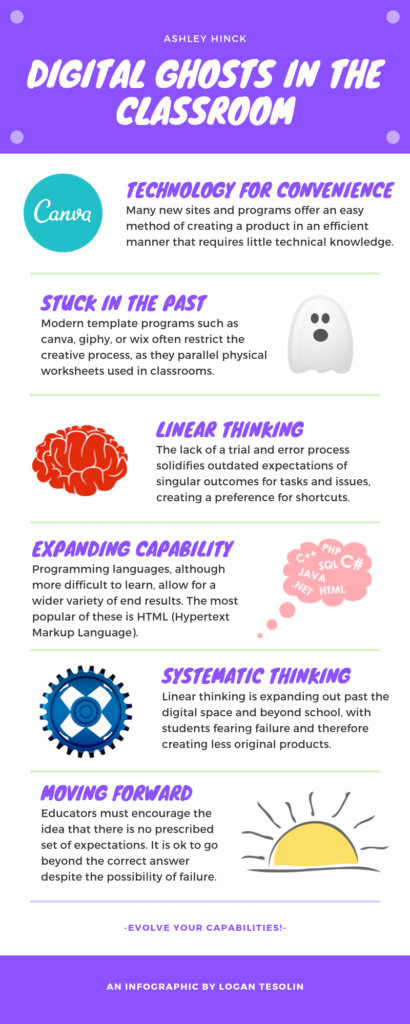
I read the article Digital Ghosts in the Modern Classroom by Ashley Hinck. First and foremost, I disagree with Hinck’s claim that template platforms “reflect traditional school culture”. There is a benefit to efficiency in technology, as it appeals to those who don’t wish to pursue mastery of complex digital techniques (such as myself). A template website like Canva saves time for the user. Rather than offering sites like these as the only option for students, it should be offered as one of many. Students like myself desire a more systematic approach to feel comfortable. The reason I chose Canva for my infographic (below) was because I found my other options too open-ended and immediately jumped to a medium that I am familiar with.

Open-endedness in of itself can intimidate those who don’t know what to do with vague expectations and all of this power to themselves. The question arises as to whether students explore best with a blank canvas or a guided hand. It would disservice those who crafted these sites to call it an intentional choice to parallel the ghosts of worksheets, as they are meant to help the less technologically-inclined. It is innovative rather than restrictive.

It should not be assumed that everyone wants or needs complex creation methods such as HTML to make something that the user is satisfied with or proud of. The majority of students coming out of high school do not desire to learn programming languages, and those that do often find ways to teach themselves and work on their own personal projects without instruction from a teacher. Opportunity does not necessarily equate to an increased demand for complexity, even if it promises a more modifiable outcome.

I do agree that schools promote a linear method of thinking that often gravitates students toward a single correct answer. I myself often stress over assignments that have an unclear final solution due to this thinking ingrained in me from high school. It makes assignments in English especially difficult to be happy with due to the open-endedness and wild variation between each student’s final product. I do not, however, believe that we should veer students away from programs that only intend to help find a solution and keep them content in the creative process. There should be a choice for the less creatively-inclined.

While I have done my best to get out of the linear thinking of aiming for one answer, I think that utilizing a resource to narrow down one’s options is helpful to students like me that draw complete blanks if instructions are too generalized. It is my theory that if one wishes to pursue a more creative outcome, they will make the effort to seek out a more advanced method of doing so. Those who do not share this desire may not know what to do with a more complicated approach.
